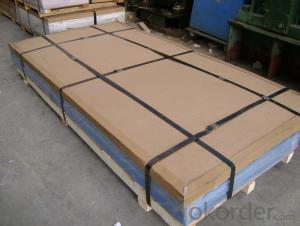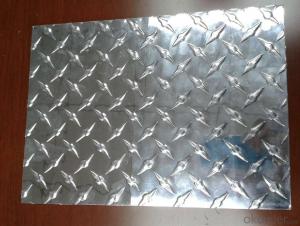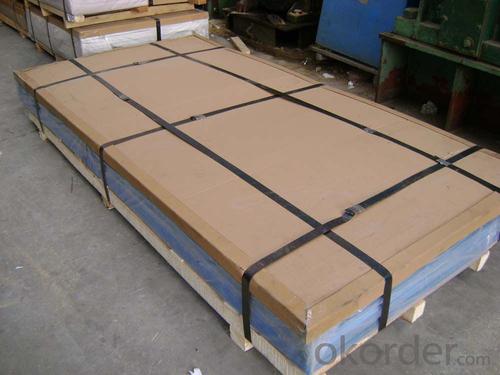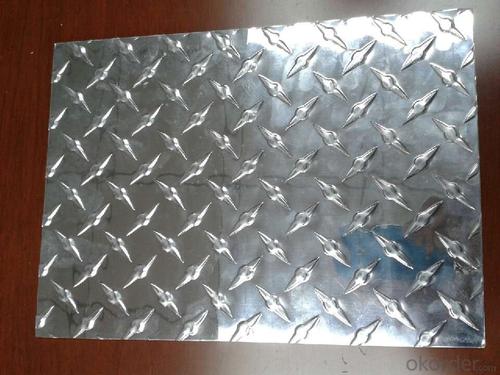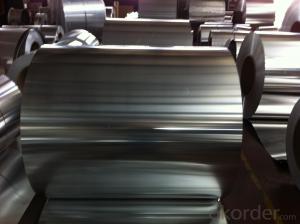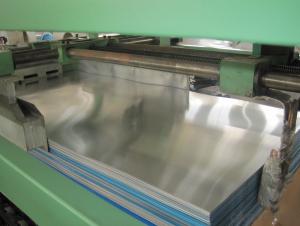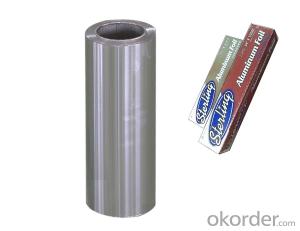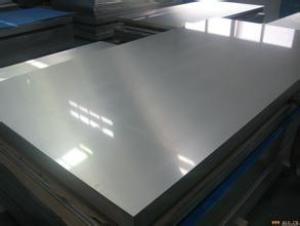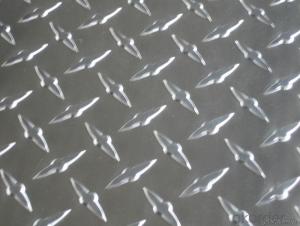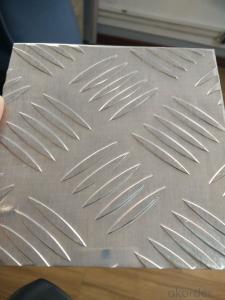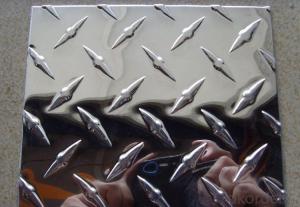Aluminum Clad Sheets - Al Plate Diamond
- Loading Port:
- China Main Port
- Payment Terms:
- TT OR LC
- Min Order Qty:
- -
- Supply Capability:
- -
OKorder Service Pledge
OKorder Financial Service
You Might Also Like
Aluminium is a relatively soft,durable, lightweight, ductile and malleablemetalwith appearance ranging from silvery to dull gray, depending on the surfaceroughness. It is nonmagnetic and does not easily ignite. A fresh film ofaluminium serves as a good reflector (approximately 92%) of visible light and an excellent reflector (asmuch as 98%) of medium and far infrared radiation. The yield strengthof pure aluminium is 7–11 MPa, while aluminium alloys have yield strengths ranging from200 MPa to 600 MPa. Aluminium has about one-third the density and stiffness of steel.It is easily machined, cast, drawn and extruded.
Aluminium alloys (or aluminum alloys; see spellingdifferences) are alloysin which aluminium(Al) is the predominant metal. The typical alloying elements are copper, magnesium,manganese,silicon,tin and zinc. There are twoprincipal classifications, namely casting alloys and wrought alloys, both of which are furthersubdivided into the categories heat-treatableand non-heat-treatable. About 85% of aluminium is used for wrought products,for example rolled plate, foils and extrusions.Cast aluminium alloys yield cost-effective products due to the low meltingpoint, although they generally have lower tensile strengthsthan wrought alloys. The most important cast aluminium alloy system is Al–Si,where the high levels of silicon (4.0–13%) contribute to give good castingcharacteristics. Aluminium alloys are widely used in engineering structures andcomponents where light weight or corrosion resistance is required
Secification:
Finishing:Mill Finish, Painted, One Side Bright, Brushed and Coil Anodizing available onrequest
Alloy: AA1050, 1060, 1100, AA3003, 3005, 3015, 5052, 5754,5083,8011, etc
Temper:H14/16/18/22/24/32,HO etc.
Thickness: 0.2mm—100mm
Width: 100mm—2300mm(Can be slitted)
Standard:GB/T 3880-2006 ASTM B-209
Features:
1. Excellent quality of products
2. Quick delivery
3. Best service to clients
4. BV,SGS avalible
5. No buckle o waveness
6. Tension leveling
7. Certificate of Origin
8. Form A,E
Packaging Detail: Carton ,Wooden pallet with plastic protection packing,standard seaworthy packing or as your request.
ProductionCapacity:
AnnualProduction capacity of 600,000 tons.
Products areexported to United States, Canada, U.A.E, Brazil, Mexico,Thailand, Vietnam,Nigeria etc, over 100 countries andregions all over the world.
Coveredfactories with full production line
CNBM aluminumproduction base is comprised of 18 aluminumannealers, 10 coil and foilmills, 4 continuous production lines, 2hot rolling production line and 3prepainted lines.
FAQ:
1. What is the form of payment?
Normally 30% TT, L/C
2. Type of quotation?
FOB, CFR, CIF
3. Port of loading?
Shanghai port
4. Delivery time?
30 day after client’s deposit
- Q: Can anyone tell me what to be careful of if you have aluminum wiring in your house. I was told that if the wall gets hot, I need to tighten the screws of the inside switch. Is this true and if I didn't, would it actually cause a fire in the wall. If this is true, how often does it loosen?
- Aluminum Rated Receptacles
- Q: Can 101 aluminum sheets be embossed or textured?
- Yes, 101 aluminum sheets can be embossed or textured. Aluminum is a versatile material that can be easily manipulated and shaped. Embossing or texturing aluminum sheets involves applying pressure or heat to create raised or recessed patterns on the surface. This process can be done with various techniques, such as mechanical embossing or chemical etching. As long as the aluminum sheets are of good quality and thickness, they can be embossed or textured to achieve desired designs and patterns.
- Q: What are the rules and standards that govern the use of aluminum sheets in construction projects?
- <p>Yes, there are regulations regarding the use of aluminum sheets in construction. These regulations vary by country and region but generally cover aspects such as material standards, safety, and environmental impact. For instance, in the United States, the American Society for Testing and Materials (ASTM) provides standards for aluminum sheet materials. Building codes like the International Building Code (IBC) also specify requirements for the use of aluminum in construction. These regulations ensure that aluminum sheets meet certain strength, durability, and performance criteria. Compliance with these regulations is crucial for safety, structural integrity, and to obtain necessary permits and approvals for construction projects.</p>
- Q: What is the hardness rating of 101 aluminum sheets?
- The hardness of 101 aluminum sheets can vary due to various factors, including alloy composition, heat treatment, and manufacturing processes. Generally, aluminum alloys are considered to have relatively low hardness compared to other metals. While the Rockwell hardness scale is commonly used for measuring metal hardness, it is not typically used for aluminum. Instead, the Brinell or Vickers hardness tests are more commonly employed for aluminum alloys. Without detailed information regarding the alloy composition and specific heat treatment applied to the 101 aluminum sheets, it is challenging to provide an exact hardness rating. Therefore, it is advised to consult the manufacturer or supplier of the specific 101 aluminum sheets to obtain accurate hardness information.
- Q: Can aluminum sheet be used for electrical enclosures?
- Yes, aluminum sheet can be used for electrical enclosures. Aluminum is a popular choice for electrical enclosures due to its excellent conductivity, lightweight nature, and corrosion resistance. It provides effective shielding against electromagnetic interference and offers good heat dissipation properties. Additionally, aluminum is easily formable, allowing for the creation of complex shapes and designs. Overall, aluminum sheet is a suitable material for electrical enclosures and is commonly used in various industries including electronics, telecommunications, and power distribution.
- Q: How are the aluminum plates cut?
- Cutting machine or plasma cutting machine, laser cutting, or electric saw. Generally thin aluminum (below 0.5mm) can be cut with a blade.
- Q: Can 101 aluminum sheets be used in the construction industry?
- Yes, 101 aluminum sheets can be used in the construction industry. Aluminum sheets are commonly used in construction due to their lightweight nature, durability, and corrosion resistance. The specific grade of aluminum, in this case, 101, may refer to the alloy composition and properties of the aluminum sheets. While there are numerous aluminum alloys available, each with its own unique characteristics, 101 aluminum sheets can certainly be utilized in various construction applications. However, it is important to note that the suitability of aluminum sheets for specific construction projects may depend on factors such as the required strength, load-bearing capacity, and environmental conditions. Therefore, it is advisable to consult with engineers or construction professionals to determine the most appropriate type and grade of aluminum sheets for a specific construction project.
- Q: What are the different surface treatments available for aluminum sheets?
- Aluminum sheets have several surface treatment options, each with its own unique properties and advantages. Anodizing, painting, powder coating, and laminating are some of the most commonly used methods. Anodizing, a popular technique, involves immersing the aluminum sheet in an electrolyte solution and passing an electric current through it. This creates a protective oxide layer on the surface, enhancing corrosion resistance, durability, and offering decorative finishes in various colors. Painting is another frequently chosen treatment. It involves applying a layer of paint to the sheet, improving aesthetics and providing protection against corrosion and environmental factors. Painting allows for a wide range of colors and finishes, making it versatile for different applications. Powder coating is an electrostatic process where a dry powder is applied to the aluminum sheet and then cured under heat. This creates a durable and attractive finish with excellent resistance to weathering, chemicals, and UV rays. It offers a variety of color options, textures, and finishes suitable for outdoor use. Laminating involves bonding a thin layer of a different material, like plastic or wood, onto the aluminum sheet. This enhances aesthetics and provides additional properties such as scratch resistance, increased strength, and insulation. Laminating offers a wide range of finishes and textures, allowing for customization and design versatility. These examples demonstrate the various surface treatments available for aluminum sheets. The choice of treatment depends on specific application requirements, desired aesthetics, durability, and environmental factors. Seeking guidance from a professional or supplier can assist in determining the most suitable surface treatment option for a particular project or application.
- Q: How do aluminum sheets handle extreme temperatures?
- Aluminum sheets have excellent thermal conductivity, allowing them to efficiently distribute and dissipate heat. They can withstand extreme temperatures without warping, melting, or becoming brittle, making them highly reliable in both high and low-temperature environments.
- Q: Can aluminum sheets be waterjet cut?
- Yes, aluminum sheets can be waterjet cut. Waterjet cutting is a versatile method that uses a high-pressure stream of water mixed with an abrasive material to cut through various materials, including metals like aluminum. The waterjet cutting process is effective for aluminum because it does not generate heat, which can potentially deform or damage the metal. It also provides high precision and accuracy, allowing for intricate shapes and designs to be cut with ease. Waterjet cutting is commonly used in industries that require precise and clean cuts in aluminum sheets, such as aerospace, automotive, and manufacturing.
Send your message to us
Aluminum Clad Sheets - Al Plate Diamond
- Loading Port:
- China Main Port
- Payment Terms:
- TT OR LC
- Min Order Qty:
- -
- Supply Capability:
- -
OKorder Service Pledge
OKorder Financial Service
Similar products
Hot products
Hot Searches
Related keywords
